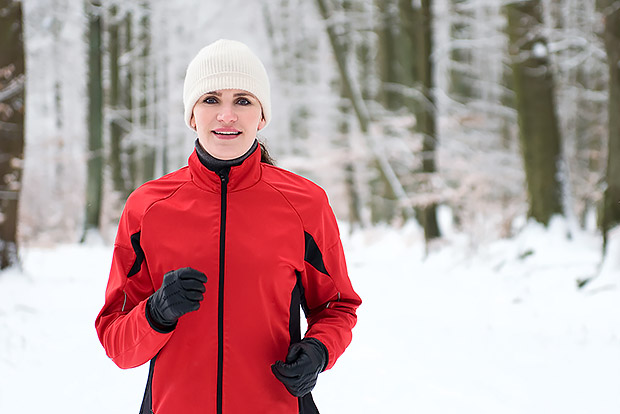
The cold weather and winter short days can put a damper on your walking program, but don't give up. Manage the challenges of winter weather, and the cold months might become one of your favorite seasons for walking.
Dress for success.
Technology has come a long way from the days of bulky winter athletic wear. Silky thermals with ventilation panels, quick-drying micro-fleece, lightweight materials that wick away moisture to keep you warm (Thermax, Thinsulate, Polypropylene, Capilene), and water-resistant shells all make it easy to dress for exercise in the cold.
Dress in layers you can peel off as you warm up. Three layers are usually sufficient: 1) a base layer to draw moisture away from the skin, 2) a middle layer to provide warmth, and 3) an outer layer to protect against wind and rain. Wear gloves or mittens with glove liners, and cover your ears and head.
Don't ignore the sun.
Don't skimp on sun protection just because it's cloudy and cold. Continue to apply sunscreen with at least 15 SPF, wear a lip balm with sunscreen, wear a hat to protect your head, and consider sunglasses to protect your eyes from the glare of a bright winter's day.
Stay hydrated.
You may not sweat as much during winter workouts as on warmer days, but winter exercise can still cause dehydration. The American College of Sports Medicine recommends that adults aim to drink around 0.4 to 0.8 liters of fluid per hour during exercise.
Stay safe at all hours.
The short days can make it difficult to walk during daylight. If you have to walk in the early morning or evening, make sure that your gear is equipped with reflective materials. Consider wearing a reflective vest and a headlamp.
Be aware of road conditions.
The worst part of winter walking is often the condition of your walking path. Watch for slippery icy patches. If you need new walking shoes, now is the time to get them. A newer pair will provide better traction.
Watch for frostbite.
In addition to the danger of falls from icy conditions, frostbite is another risk of exercising in cold weather. Frostbite starts as frostnip, where the skin turns bright red, is very cold, and may tingle. Exposed areas, such as fingers, toes, ears, and the nose, are the most susceptible. Ignoring these symptoms can lead to superficial frostbite, where the skin turns white, and damage can begin to occur. Cover all exposed skin and get inside if frostbite symptoms begin.
Assess your indoor options.
When it's simply too cold, look for indoor walking options in your community. Shopping malls often open early for walkers. The perimeters of supermarkets also offer a sufficient walking area. If a treadmill is your only option, plan your workout during your favorite television show, and use interval training with speed and inclines to make the session less monotonous. Walking videos and podcasts are great options for at-home workouts.
Consider other activities.
While you may love walking, winter can provide the perfect opportunity to try something new. Try a weight training class, indoor cycling, or dance lessons.
Sources



 5 Ways to Burn 300 Calories this Weekend
5 Ways to Burn 300 Calories this Weekend
 The Best Home and Garden Chores for Burning Calories
The Best Home and Garden Chores for Burning Calories
 5 Tips for Making Exercise a Habit
5 Tips for Making Exercise a Habit
 Best Ways to Stay Safe during Exercise in Hot Weather
Best Ways to Stay Safe during Exercise in Hot Weather
 11 Tips for Exercise Motivation
11 Tips for Exercise Motivation
 Signs You Need to Increase Exercise Intensity
Signs You Need to Increase Exercise Intensity
 Mistakes to Avoid When Setting Fitness Goals
Mistakes to Avoid When Setting Fitness Goals
 Essential Gear for Starting an Exercise Program
Essential Gear for Starting an Exercise Program

 Pinterest
Pinterest RSS Feed
RSS Feed